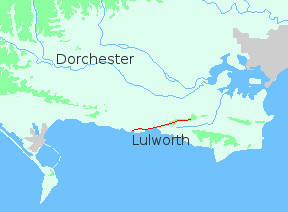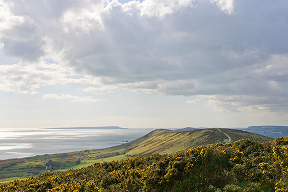
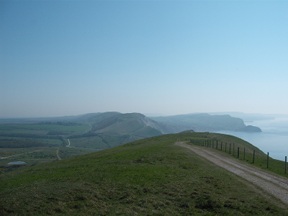
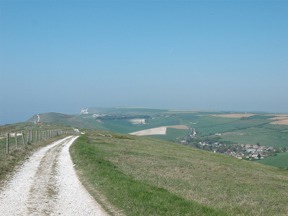
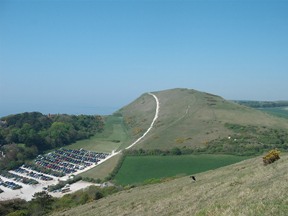
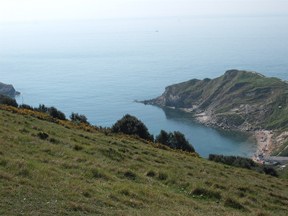
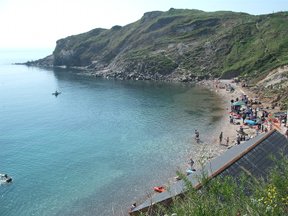
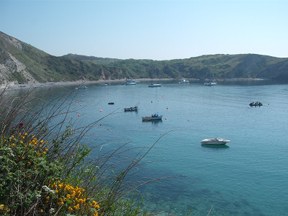
The Folly above Creech Grange was built at a time when landowners went in for fake battlements on hillsides overlooking their country seat. Viewed from the terrace, they presumably imparted to an otherwise orderly landscape a wild, romantic look - and also distracted the gaze from whatever ghastly examples of 19th century architecture lay closer to hand! (As P. G. Wodehouse rightly remarked, "Whatever may be said in favour of the Victorians, it is pretty generally admitted that few of them were to be trusted within reach of a trowel and a pile of bricks.")
I mention the subject, because it was while attempting to photograph this particular Folly that I realized that the batteries in the camera were flat. As were the spares. So there I was, on a fine spring morning, with the early sunshine spilling over the ridge and flooding the valley far below, and up ahead the wide expanse of the sea bright beneath a clear sky, and I couldn't record a damn thing for posterity!
I set off along the escarpment, cursing as I spotted endless photo opportunities. To my left the land sloped steeply to the deserted village of Tyneham. Coppices cool and thick with bluebells clung to the side of the hill. On the other side of the ridge the high ground fell away to pine and heathland, and the tangled tracks of the Lulworth ranges. The path led on, through thickets of gorse dusted with gold. In the far distance the long bulk of Portland lay along the horizon.
The track was bordered with yellow poles; an unnecessary precaution, it seemed, until I remembered that I was on a firing range, and thought of the dense fogs rolling in from the sea. There was no risk of getting lost that morning; the path was clear enough. I could see most of the way to Lulworth, though the cove itself was hidden beneath the immense slab of Bindon Hill.
After several miles I reached Flowers Barrow. The name is misleading; it's actually an early Iron Age hill fort. Poised high above Worbarrow Bay, it commanded the ridge leading to the interior of Purbeck. Only part of the fort is left,the rest having collapsed as a result of costal erosion. I passed through the ramparts and crossed the sheltered, grassy interior - a pleasant place to rest for a while.
From Flowers Barrow the path plummets five hundred feet to the small cove at Arish Mell. The beach is fenced off; which is unfortunate, since on leaving the cove you immediately begin the long slog up to the summit of Bindon Hill, regaining all the height shed. One of the reasons I've never fancied the South West Coastal Path is its propensity to veer wildly between high cliff-tops and sea level. According to Wikipedia, the height climbed over the course of the walk is around four times that of Mount Everest!
A long flight of wooden steps, partly decayed, brought me at last to the top. The views were out of this world. I looked back the way I had come, along the ridge rolling like a great wave over Purbeck. Crossing the summit I saw the coastal hills, running on through Dorset and further still. It was all so wonderful that I dug out the camera, just in case.
And it worked! Perhaps the warmth of the rucksack had re-energized the batteries, but at any rate the thing flickered into life. I took some photos, resisting the temptation to blaze away (not easy when you are standing on what feels like the roof of the world). Then I set off once more, along the track to Lulworth.
As it descended, the path turned to the left, making for the cove. Far below, I could see the crowded car park by the visitor centre, and on the further hillside a line of black specs marching like ants along the path to Durdle Dor. Then the open hillside gave way to woods, and I followed the winding way, until I emerged from the trees onto the beach.
It was chaos! Though the shingle was already crowded, more and more people clutching towels were forcing their way to the sea. I beat a hasty retreat, through the noise and confusion, until I found myself alone on the road leading to West Lulworth.
The village is a mile or so inland, and much quieter than the Cove. It was still early when I reached the Castle Inn, and I had an hour to waste; so I settled down with a pint and a sandwich, drowsing in the warm sunshine, until the bus came to take me on to Wool station.
